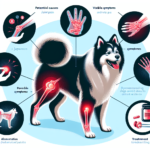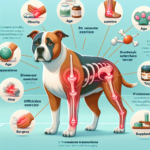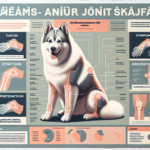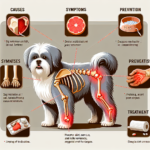Japanese Spitz Joint Pain: Causes, Symptoms, Prevention, and Treatment

Introduction
The Japanese Spitz is a small to medium-sized breed known for its fluffy white coat, pointed ears, and friendly demeanor. Originating in Japan in the early 20th century, this breed was developed by crossbreeding various Spitz-type dogs, including the German Spitz. The Japanese Spitz is celebrated for its playful and affectionate nature, making it a popular companion dog. Despite its robust appearance, the breed is prone to certain health issues, including joint pain, which can significantly impact its quality of life.
General health concerns for the Japanese Spitz include dental issues, patellar luxation, and skin allergies. However, joint pain is a particularly pressing issue that can affect the breed’s mobility and overall well-being. Understanding the causes, symptoms, prevention, and treatment of joint pain in Japanese Spitz dogs is crucial for ensuring their long-term health and happiness.
Joint health is especially important for the Japanese Spitz due to their active nature and relatively long lifespan, which can range from 12 to 16 years. Maintaining healthy joints can help prevent pain and mobility issues as the dog ages, allowing them to enjoy a more active and fulfilling life.
Breed-Specific Joint Pain Risks
Genetic Predisposition
Like many purebred dogs, the Japanese Spitz is genetically predisposed to certain joint-related issues. Hip dysplasia, a condition where the hip joint doesn’t fit properly into the hip socket, is one such concern. This can lead to arthritis and chronic pain over time. Elbow dysplasia, another genetic condition, affects the elbow joint and can also result in long-term discomfort and mobility issues.
Age-Related Risks
As the Japanese Spitz ages, the risk of developing joint pain increases. Older dogs are more susceptible to arthritis, a degenerative joint disease that causes inflammation and pain. For the Japanese Spitz, significant age milestones to watch for include the onset of middle age (around 6-8 years) and senior years (10 years and older). Regular veterinary check-ups are essential during these stages to monitor joint health.
Activity Level and Joint Stress
The Japanese Spitz is an active breed that enjoys playtime and exercise. While regular activity is beneficial for overall health, excessive or high-impact activities can put stress on the joints. Activities like jumping, running on hard surfaces, or engaging in strenuous exercise can exacerbate joint issues, especially if the dog is genetically predisposed to them.
Common Symptoms of Joint Pain in Japanese Spitz
General Symptoms
Owners should be vigilant for common symptoms of joint pain, which include:
- Limping or favoring one leg
- Stiffness, especially after rest or sleep
- Reluctance to move, jump, or climb stairs
- Decreased activity or playfulness
- Visible discomfort or pain when touched
- Swelling around the joints
Breed-Specific Symptoms
In the Japanese Spitz, joint pain may manifest more subtly due to their stoic nature. Owners might notice a decrease in the dog’s usual playful behavior or a reluctance to engage in activities they once enjoyed. Additionally, the breed’s thick coat can sometimes mask visible signs of swelling, making it crucial to pay attention to behavioral changes.
When to Consult a Vet
If any of the above symptoms are observed, it is essential to consult a veterinarian promptly. Early diagnosis and intervention can significantly improve the dog’s quality of life and prevent further joint deterioration. Regular veterinary check-ups are also recommended to monitor joint health, especially as the dog ages.
Preventive Measures for Joint Health
Exercise Recommendations
Maintaining an appropriate exercise routine is crucial for the Japanese Spitz. Low-impact activities such as walking, swimming, and gentle play are ideal for keeping the joints healthy without causing excessive stress. Avoid high-impact activities like jumping or running on hard surfaces, which can exacerbate joint issues.
Dietary Suggestions
A balanced diet rich in essential nutrients can support joint health. Foods containing glucosamine, chondroitin, and omega-3 fatty acids are particularly beneficial. These nutrients help maintain cartilage health and reduce inflammation. Consider incorporating high-quality commercial dog foods formulated for joint health or consult your veterinarian about appropriate supplements.
Weight Management
Maintaining a healthy weight is vital for reducing joint stress. Excess weight can exacerbate joint pain and lead to other health issues. Monitor your dog’s weight regularly and adjust their diet and exercise routine as needed. For the Japanese Spitz, a healthy weight range typically falls between 10-25 pounds, depending on their size and build.
Early Screening and Monitoring
Early screening for joint issues can help catch problems before they become severe. Regular veterinary check-ups should include joint assessments, especially as the dog ages. X-rays and other diagnostic tools can help identify early signs of joint problems, allowing for timely intervention.
Treatment Options for Joint Pain
Non-Surgical Treatments
Non-surgical treatments for joint pain in the Japanese Spitz include:
- Medications: Anti-inflammatory drugs and pain relievers can help manage pain and reduce inflammation.
- Physical Therapy: Exercises and therapies designed to improve joint mobility and strength can be beneficial.
- Lifestyle Adjustments: Modifying the dog’s activity level and environment to reduce joint stress can help manage pain.
Surgical Options
In severe cases, surgical intervention may be necessary. Common surgical options include:
- Hip Replacement: Replacing the damaged hip joint with an artificial one can significantly improve mobility and reduce pain.
- Arthroscopy: A minimally invasive procedure to clean out the joint and remove damaged tissue.
- Joint Fusion: Fusing the joint to stabilize it and reduce pain, typically used for severe arthritis.
Alternative Therapies
Alternative treatments can also be beneficial for managing joint pain in the Japanese Spitz. These include:
- Acupuncture: This traditional Chinese medicine technique can help reduce pain and improve joint function.
- Hydrotherapy: Water-based exercises that reduce joint stress while improving mobility and strength.
- Massage: Regular massage can help alleviate muscle tension and improve circulation around the joints.
Lifestyle and Management Tips
Daily Care Routine
A sample daily care routine for managing joint pain in the Japanese Spitz might include:
- Morning: Gentle walk or swim to loosen joints and improve mobility.
- Midday: Administer any prescribed medications or supplements.
- Afternoon: Light playtime or another gentle walk.
- Evening: Massage or physical therapy exercises to relax muscles and joints.
Modifying the Home Environment
Making the home more comfortable for a dog with joint pain can significantly improve their quality of life. Consider the following modifications:
- Install ramps to help the dog navigate stairs or get onto furniture.
- Provide orthopedic beds to support joints and reduce pressure points.
- Ensure food and water bowls are at a comfortable height to reduce strain on the neck and joints.
Long-Term Management
Long-term management strategies for joint pain in the Japanese Spitz include:
- Regular veterinary check-ups to monitor joint health and adjust treatment plans as needed.
- Consistent weight management to reduce joint stress.
- Ongoing physical therapy or alternative treatments to maintain mobility and reduce pain.
FAQs About Japanese Spitz and Joint Pain
What are the early signs of joint pain in a Japanese Spitz?
Early signs of joint pain include limping, stiffness, reluctance to move, and decreased activity levels. If you notice any of these symptoms, consult your veterinarian promptly.
Can joint pain in Japanese Spitz be prevented?
While genetic predispositions cannot be entirely prevented, maintaining a healthy weight, providing appropriate exercise, and regular veterinary check-ups can help reduce the risk and severity of joint pain.
Are there specific foods that can help with joint health?
Yes, foods rich in glucosamine, chondroitin, and omega-3 fatty acids can support joint health. Consult your veterinarian for dietary recommendations tailored to your dog’s needs.
Is surgery always necessary for joint pain in Japanese Spitz?
No, surgery is not always necessary. Many cases of joint pain can be managed with non-surgical treatments such as medications, physical therapy, and lifestyle adjustments. Surgery is typically considered for severe cases.
How often should I take my Japanese Spitz to the vet for joint health check-ups?
Regular veterinary check-ups are recommended at least once a year, but more frequent visits may be necessary as the dog ages or if joint issues are present.
Conclusion
Joint pain is a significant concern for the Japanese Spitz, but with proper care and attention, it can be managed effectively. By understanding the causes, symptoms, prevention, and treatment options, owners can help ensure their dogs lead active and happy lives. Regular veterinary check-ups, a balanced diet, appropriate exercise, and weight management are crucial for maintaining joint health. If joint pain does occur, early intervention and a comprehensive treatment plan can make a significant difference in the dog’s quality of life.
Remember, proactive care and regular consultation with your veterinarian are key to keeping your Japanese Spitz healthy and happy.




